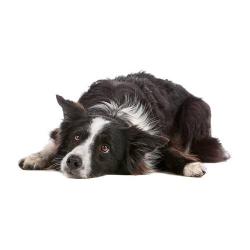How to train the dog to stay home alone

Why Can’t My Dog Be Alone?
A common complaint of new pet parents is that their pups are destructive or disruptive when left alone at home. While these problems may just be a sign that your dog needs to be taught polite house manners, they can also indicate an anxiety disorder called “separation anxiety.” This disorder is triggered when dogs become upset because of separation from the people they’ve become attached to. Escape attempts by dogs with this problem can result in self-trauma and destruction of window, doors, and walls in your home.
Symptoms
Dogs with separation anxiety can act in a variety of destructive, disruptive ways and have a number of behaviors that work separately or together to provide a clear picture of an emotionally disturbed animal.
When left alone, some dogs will begin to persistently bark and howl, may start digging or chewing their “escape route” out of a room or crate, and will not stop these behaviors until the owner comes home and pays them attention. Other animals, even though completely house broken when the owner is at home, will urinate or defecate in the house. Some of these dogs will eat all or part of their excrement in an emotionally driven behavior called “coprophagia.” Some animals with this type of anxiety disorder have been known to leap high fences, eat through doors, or jump through glass doors to escape and get to their owners. The less-destructive types are “pacers” – they will wear a path in your carpet or yard pacing back and forth, back and forth until you come home.
Causes
Animal behaviorists and veterinarians draw no real conclusions as to the causes of separation anxiety in some animals. If the dog has been particularly close to an owner or a family and is then abandoned or surrendered to a shelter, this can activate the development of this disorder. A move to a new residence, a change in the owner’s schedule, the sudden absence of a family member due to death or divorce, even something as simple as a change in the owner’s work schedule has been known to trigger episodes of separation anxiety. It seems many anxiety-ridden dogs come from multiple homes or have been transferred from shelter to shelter.
Many veterinary behaviorists believe that dogs with this particular disorder may have been weaned too early from their mothers, or the mothers became unavailable to the puppies due to illness or death. In other situations, the mother dog may have neglected or rejected the anxious puppy, or provided little physical stimulation.
If you’ve had your veterinarian rule out any medical problems causing this particular behavior, re-training your dog to accept your goings and comings may be your only option.
Treatment
For cases of mild separation anxiety, where complete destruction of property is not shown, but you notice signs of agitation or fearfulness, helping your dog associate being alone in the home with something good or something the dog loves may be the answer.
For example, if your pet loves to play with a particular toy or eat a certain treat food, you can offer your dog a rubber Kong toy stuffed with peanut butter or low-fat cream cheese to puzzle through when you leave the house. That should keep her occupied for 20 to 30 minutes and allow her to relax when you are gone. Make sure to pick up the toy when you return and don’t give it to her unless you are leaving the house. She needs to be able to associate you being absent with her getting her toy and her favorite food in order to become less anxiety prone.
For more moderate to severe cases of separation anxiety, you will need to desensitize your pet to whatever action initiates the agitation and recondition her to accept that being alone can bring good things instead of fear and apprehension.
For example, if you notice that she gets anxious and begins whining whenever you put on your coat to go outside, put on your coat, give her a treat and some attention, and don’t leave the room. Do this several times over a period of days until she is no longer showing anxiety when she sees your coat.
The next step in her training is for you to put on your coat, give her a treat and some attention, then quickly go out the front door and stay out for just 3 to 5 seconds. Come back in, praise and reward her, then take off your coat and stay. Practice this maneuver until she is no longer anxious, and then begin lengthening the time you stay outside until you can go out without any reaction at all from her.
This entire training process can last anywhere from a week to several months, depending on the severity of your dog’s anxieties.
Medications
Your veterinarian may be able to help calm some of your dog’s fears by using prescribed anti-anxiety medications. Some pets become so agitated at the thought of being away from their owners that medication is necessary before any training and reprogramming can be undertaken.
What not to do
Don’t scold or punish your pooch for behaviors she can’t help. Her responses are results of stress from being left alone and NOT from spite or disobedience. Punishment can cause the problem to get much worse.
Please Note: Consult your veterinarian before giving your pup any anti-anxiety medications. If training at home isn’t working, a veterinary behaviorist who can work with both you and your dog may be just what you need to overcome this problem.
